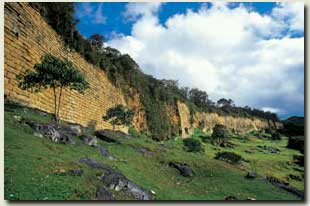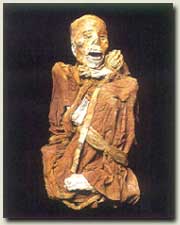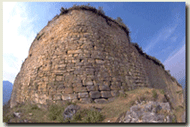LIGHT ADVENTURE STARTING FROM CHICLAYO
This classic five-day fixed departure to the lost kingdom of the Chachapoyas features visits to the huge mountaintop temple and fortress of Kuelap, The Leimebamba museum with its collection of 200 mummies, the Revash tombs and the Macro towers. Our final day offers alternative hikes, either to spectacular Gocta Falls, the world´s third highest waterfall, or to the eerily impressive terracotta sarcophagi of Karajía. This region is still new to tourism, but we have taken every care to provide as comfortable a stay as possible, with air-conditioned vehicles, expert guides and the best possible accommodation.
The tour includes short treks on foot and/or horseback, and the cost covers all land travel and meals and accommodation at the charming El Chillo Hacienda Lodge (3 nights), and at a local Chachapoyas hotel.
Please note that is high recommended overnight in Chiclayo the night previous to the tour beginning, this is in order to avoid flight delays
PROGRAM
| Duration | 5 Days and 4 Nights |
| Departures | Available on Wednesdays and Saturdays from May to October |
| Activities | Chachapoyas, Kuelap citadel, Leymebamba – starting from Chiclayo |
| Airfares | Not included, available upon request |
DAY 1 CHICLAYO TO CHACHAPOYAS: ACROSS THE ANDES TO THE AMAZON.
We drive northward from Chiclayo across Peru’s coastal plains, following the Pan-American Highway, then turn east onto the Trans-Andean route, ascending gently through regions of dry forest interspersed with irrigated farmland. Our road loops towards the lowest pass of the Peruvian Andes, at 2,135m/7,000 ft, where we cross the continental divide and enter the Upper Amazon basin. Following the valley of the Huancabamba/Chamaya river system we pass broad ribbons of bright green rice terracing, forming a striking contrast with the cactus and dense thorn-scrub vegetation of the mountainsides. Lower downstream we pass the massive dam and intake of the Olmos irrigation project, ultimately destined to divert much of this water through a 23Km/14.2 mile long tunnel to the Pacific slope of the Andes.
We reach the bridge over the Marañon, one of the great tributaries of the Upper Amazon, which was formerly believed to be the source of that mighty river. Here we enter the Peruvian department of Amazonas, former home of a mysterious and powerful civilization, the Chachapoyas, whose remnants we will explore during this journey.
We follow the Utcubamba river, the main artery of the Chachapoyan heartland, first ascending a dramatic canyon then winding up the mountainous valley which leads us to El Chillo, the charming hillside garden hotel which will be our home for the next three nights. (Box Lunh, D)
DAY 2 CHACHAPOYAS: JOURNEY TO THE CLIFF TOMBS OF REVASH AND ON TO LEIMEBAMBA.
We follow the Utcubamba valley upstream, spotting herons and perhaps an Andean torrent duck in the river as we slowly ascend the valley. At the village of Santo Tomás we turn off the main highway, crossing the river and ascending a side valley where vivid scarlet poinsettias the size of trees overhang the walls of typical Chachapoyan farms, with verandas surrounded by wooden columns, and topped with tile roofs. Soon we meet our wranglers and the calm, sure-footed horses that will carry us up the trail to Revash.
Throughout this journey we gaze up at huge cliffs that loom ever closer. These limestone formations, laid down in even layers over geological aeons, tend to break away in neat collapses, often leaving extensive overhangs and protected ledges beneath them. In such places the ancient Chachapoya built the tombs where they buried their noble dead.
A gigantic fold in the cliffs, testifying to millennia of unimaginable tectonic forces, lies ahead of us, and at the top of the fold one such cave houses a group of tombs, ruined structures still bearing their original coat of red and white pigment. But they are far off, and this is not yet Revash. Another hour brings us to a viewpoint much closer to the cliffs, and here we see two adjacent sets of caves, featuring cottage-sized structures covered in still-bright mineral-oxide paintwork. Some of them look like cottages, with gabled roofs, others like flat-topped apartments. They are adorned with red-on-white figures and geometrical symbols — a feline, llamas, circles, ovals — and bas-relief crosses and T-shapes, which perhaps once told the rank and lineage of the tombs’ occupants. They are silent, empty, their contents long ago looted, their facades still trying to tell us a story whose meaning was lost long ago.
Retracing our steps we continue our road journey to Leimebamba, which we reach mid-afternoon. This settlement was established by the Incas during their conquest of the region, and continued as a colonial town under the Spanish. It retains much of this antique charm in its balconied houses with narrow streets where more horses than cars are parked. We go a little further up the highway and pull in to the spacious garden environment of the Leimebamba Museum, where we visit a delightful collection of extraordinary artifacts recovered from another group of cliff tombs discovered as recently as 1997 at the remote Laguna de los Condores, high in the mountains east of the town.
The exhibits, cheerfully displayed in well-lit rooms, offer a sample from the mass of artifacts recovered from this amazing discovery. In 1997 a group of undiscovered cliff tombs — similar in style to those of Revash — was spotted above the remote Laguna de los Condores by local farmhands. Although they looted and damaged the site, a mass of priceless objects and a trove of vital information was rescued. We see gourds carved with animal and geometrical symbols, an array of colorful textiles, ceramics, carved wooden beakers and portrait heads, and a selection of the dozens of quipus (Inca knotted-string recording devices) recovered from the site. A big picture window offers a view of the temperature- and humidity-controlled temporary “mausoleum” where more than two hundred salvaged mummies are kept.
Archaeologists are still uncertain as to how most of this material came to be so startlingly well-preserved, in tombs that during the rainy season were actually behind a waterfall! But perhaps the most striking thing about the tombs is that they contain burials from all three periods of local history: the Chachapoya cultural heyday, the post-Inca invasion period, and the post-Spanish conquest. Archaeologists are continuing to study the material, seeking to learn more about the Chachapoya and their relationship with their Inca masters. The quipu finds have been especially valuable to scholars seeking to decode the Inca record keeping system.
After our museum tour we can visit the Kenticafé across the street, for a cup of the best coffee in Chachapoyas, where we may see dozens of the region’s exotic hummingbirds flitting among the strategically placed feeders, perhaps including the dazzling and highly endangered Marvellous Spatuletail.
We return to El Chillo for dinner and overnight. (B, Box Lunch, D)
DAY 3 CHACHAPOYAS: KUELAP, THE GREAT WALLED CITY OF NORTHERN PERU.
We spend a full day visiting this huge and mysterious site, beginning with a drive through places whose names — Choctamal, Longuita, and Kuelap itself — evoke a lost language and a vanished ancient people who spoke it, the Chachapoyans. We don’t know what they called themselves, but the Incas who finally conquered these fierce warriors knew them by their Quechua soubriquet, Chachaphuyu — Cloud People — after the cloud-draped region where they lived.
Kuelap’s existence was first reported in 1843. For years it was believed to have been a Chachapoyan fortress, and when we first catch sight of it from the fossil-encrusted limestone footpath that leads there it is hard to believe it was not. The massive walls soar to a height of 19m/62ft and its few entranceways are narrow and tapering, ideal for defense. Yet the archaeological evidence now suggests that this was principally a religious and ceremonial site.
Chachapoyas was not a nation, or an empire, but some sort of federation of small states centered on numerous settlements scattered across their mountainous territory. The earliest settlement dates obtained here suggest that its construction began around 500A.D. and, like the Moche coastal pyramids, it was built in stages as a series of platforms, one atop the other.
It is now a single enormous platform nearly 600m/2,000ft long, stretched along a soaring ridgetop. Seen from below, its vast, blank walls give no hint of the complexity and extent of the buildings above. When we reach its summit we find a maze of structures in a variety of styles and sizes, some of them faced with rhomboid friezes, some ruined and some well preserved. Here we can try to imagine the lives of the Chachapoyan elite and their servants who lived here, enjoying a breathtaking view of forested Andean mountains and valleys.
So distant and neglected was this region until recently that little archaeological research has been done at this important site, and our knowledge of it remains vague. An adjacent site named La Mallca, larger though less dramatic than Kuelap, has not been studied at all.
Even today, Kuelap’s remoteness ensures that only a handful of other visitors are there to share it with us.
We drive to Chachapoyas city for dinner and overnight at Casa Vieja Hotel. (B, Box Lunch, D)
DAY 4 CHACHAPOYAS: SPECTACULAR HIKES TO EITHER GOCTA FALLS, OR THE CLIFF TOMBS OF KARAJÍA
Here we have the option to choose between two very different and spectacular hikes:
Gocta. We drive to the city of Chachapoyas and on to the village of Cocachimba, the trailhead for this lovely walk through forest and farmland to the foot of the world’s third highest waterfall. Amazingly, the existence of these falls was not known to the world until they were spotted by a German explorer in 2006! Local people lived in fear of them and stayed away, owing to their ancient legend of a dangerous enchantress, the siren who lived in the falls. Our walk takes approximately three hours each way, and along the route we have a good chance of spotting the Andean Cock-of-the-Rock, Peru’s national bird. The male of this large, brilliantly colored red-and-black member of the cotinga family sports a huge crest that completely envelops its beak. When the males gather they hop from branch to branch through the trees, insulting each other with loud squawks and screeches in an attempt to attract females.
We hear the thunder of Gocta before we see the falls, a huge two-stage torrent of water falling from the towering limestone cliffs characteristic of the entire region. When we are close they are so high that the rim of the falls, 771m/2,528ft above us, seems to be lost in the sky. We can spend some time here enjoying the refreshing mist of the falls and enjoying the surrounding forest, viewing hummingbirds, toucanets, and, with luck, a troupe or two of capuchin or woolly monkeys. During the dry season when the volume of water is not too ferocious, those willing to face the chilly waters (and perhaps the siren!) can bathe in the pool beneath the falls. We hike back to Cocachimba and return to Chachapoyas in time for dinner.
Karajía. We drive half and hour from Chachapoyas to the village of Caclic, and then take a side road for about 1 ½ hours, before beginning a descent of 300m/1000ft, to the clifftop at Cruz Pata, then take a level path which we follow for a short way to the foot of even higher cliffs. Here we can look across a vertical cliff face to a completely inaccessible cave where the ancient Chachapoyans somehow installed nine tall clay figures, up to some 3m high, inside which the bodies of chieftains and perhaps their families were interred. One of the figures has been destroyed by falling rocks, and one damaged. The others are intact. The heads have angular, stylized faces, made of clay, while the bodies of the figures were made on site of wattle and clay, which was then covered in brightly painted designs. On top of the heads sit skulls, but whose skulls they were we cannot even guess at, because these figures have been left undisturbed, not studied by archaeologists, and thankfully not destroyed by looters. How the ancient Chachapoyans reached this place to create this burial site for their elites is still a mystery.
We return to the city of Chachapoyas in the afternoon. (B, Box Lunch, D)
DAY 5 CHACHAPOYAS TO CHICLAYO: BACK ACROSS THE MIGHTY MARAÑÓN.
After an early breakfast we return to Chiclayo by road. We will make a pleasant stop at a suitable spot along the way to eat our box lunch. We arrive in Chiclayo in the late afternoon and transfer to your selected hotel. (Overnight by your own) (B, Box Lunch)
END OF THE SERVICES

Kuelap Fortress

Pre-Inca Mummie

Kuelap
WOULD YOU LIKE TO BOOK THIS TOUR ? ASK FOR AVAILABILITY
INCLUDES: All hotel and lodge accommodations based on double or single occupancy. All scheduled transportation. All transfers. All scheduled excursions with English-speaking guide services. All entrance fees. Meals as specified in the itinerary. B=Breakfast; L=Lunch; D=Dinner.
IMPORTANT: For a better service, the company informs you that it has autonomy to change the Hotels mentioned in the itinerary with another one of similar category if therefore sees it by advisable taking into account justifiable availability of spaces or other reasons, if this it is the case you will be notified ahead of time.
NOT INCLUDED IN THE FEE
International and domestic airfares, airport departure taxes or visa fees, excess baggage charges, additional nights during the trip due to flight cancellations, alcoholic and non-alcoholic beverages or bottled water, snacks, insurance of any kind, laundry, phone calls, radio calls or messages, reconfirmation of international flights and items of personal nature



